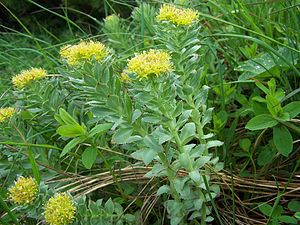Difference between revisions of "Rhodiola rosea"
Jump to navigation
Jump to search
(cut down) |
m (rm broken ref) |
||
| Line 15: | Line 15: | ||
Most commonly seen as a medicinal/herbal tea, it can also be eaten as a vegetable: | Most commonly seen as a medicinal/herbal tea, it can also be eaten as a vegetable: | ||
| − | The leaves and shoots are eaten raw, having a bitter flavor, or cooked like spinach, and are sometimes added to salads. | + | The leaves and shoots are eaten raw, having a bitter flavor, or cooked like spinach, and are sometimes added to salads.<ref>{{cite book | author = Saratikov A.S. | title = Golden Root (Rhodiola Rosea) | edition =2nd | publisher = Publishing House of Tomsk University | year = 1974 | page = 158}}</ref> |
==References== | ==References== | ||
Latest revision as of 20:23, 6 June 2018
| Rhodiola rosea | |
|---|---|

| |
| Scientific classification | |
| Kingdom: | Plantae |
| Clade: | Angiosperms |
| Clade: | Eudicots |
| Order: | Saxifragales |
| Family: | Crassulaceae |
| Genus: | Rhodiola |
| Species: | R. rosea
|
| Binomial name | |
| Rhodiola rosea | |
| Synonyms[1] | |
Most commonly seen as a medicinal/herbal tea, it can also be eaten as a vegetable:
The leaves and shoots are eaten raw, having a bitter flavor, or cooked like spinach, and are sometimes added to salads.[2]
References
- ↑ Reid V. Moran (2009), "Rhodiola rosea Linnaeus, Sp. Pl. 2: 1035. 1753", Flora of North America online, 8
- ↑ Saratikov A.S. (1974). Golden Root (Rhodiola Rosea) (2nd ed.). Publishing House of Tomsk University. p. 158.